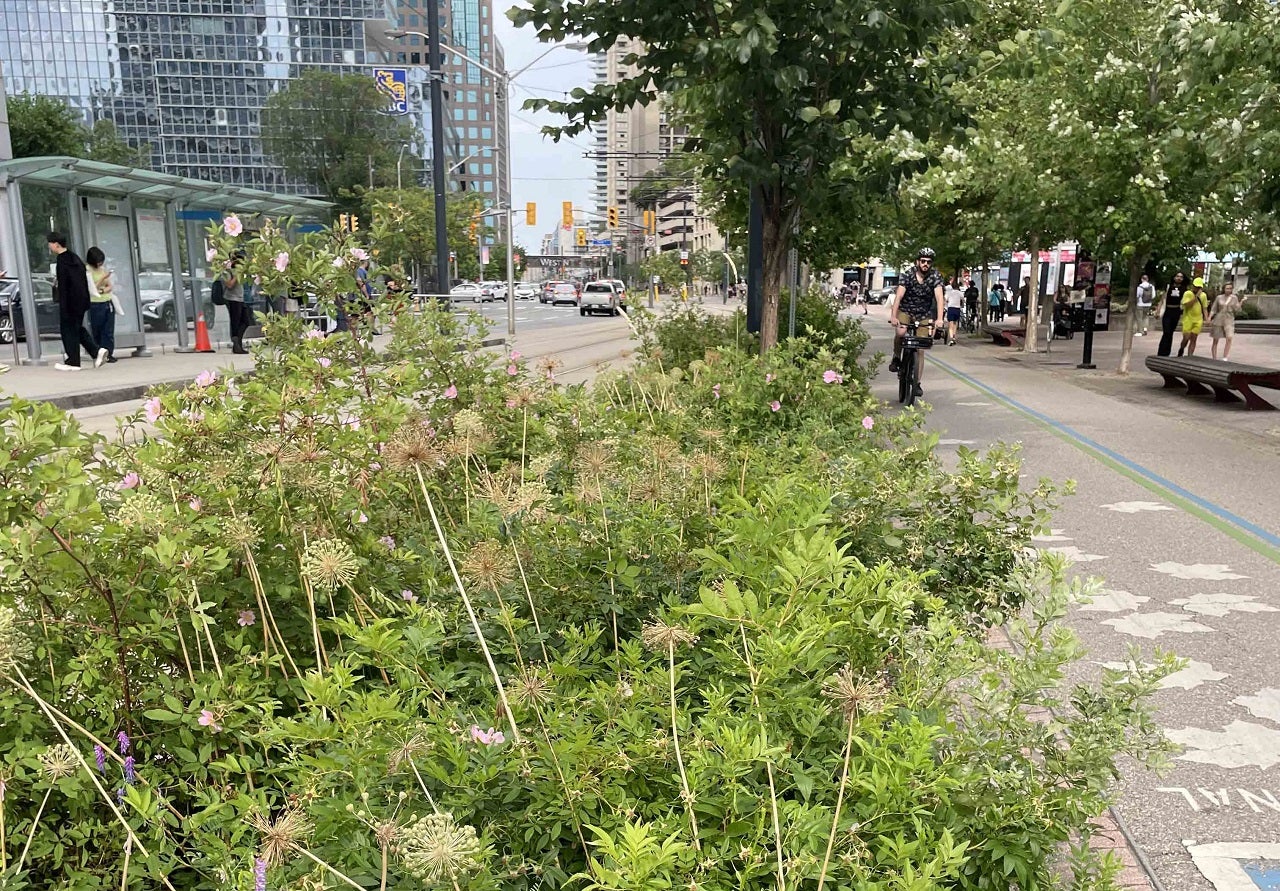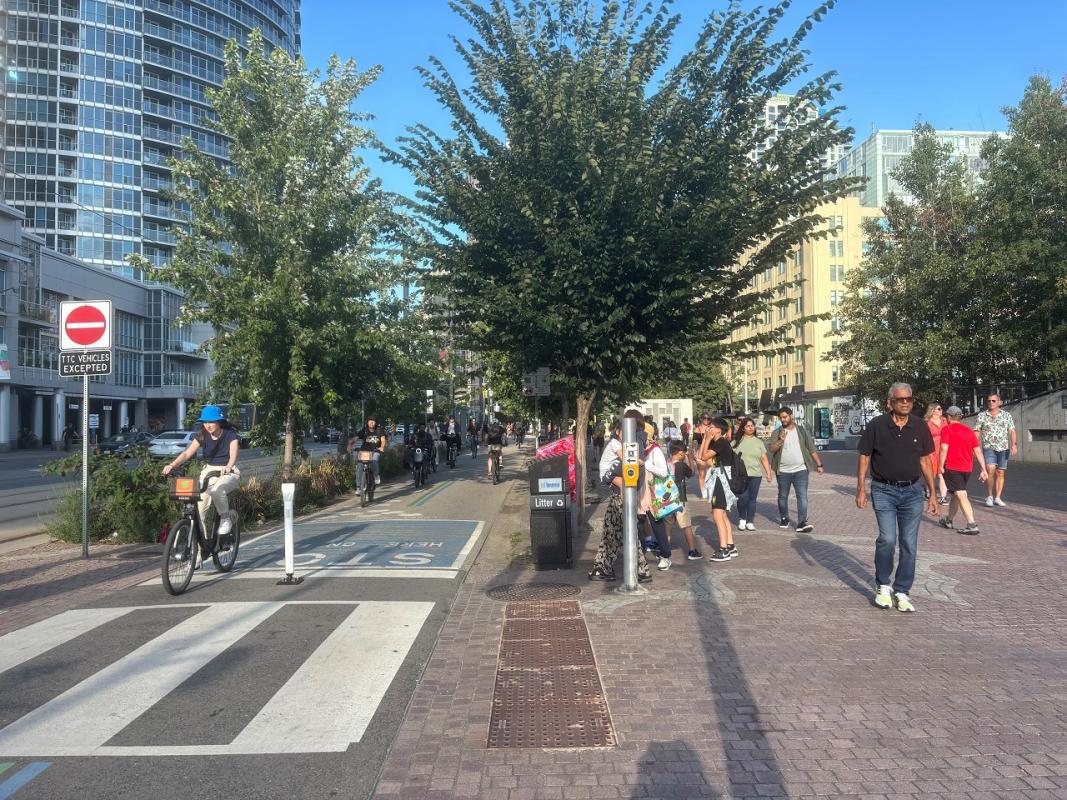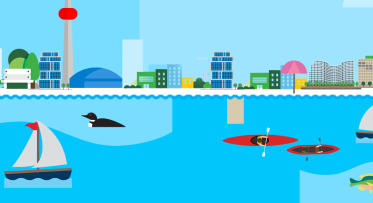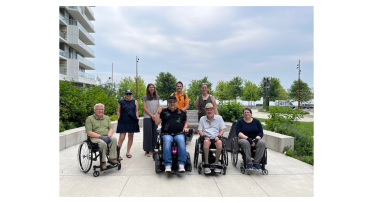Improvements from Queens Quay West Pilot Project
PUBLISHED: September 5, 2024
In This Blog:
- In 2022, we worked with the City of Toronto and the TTC on a pilot project to test ways to improve the intersections along Queens Quay West for pedestrians, cyclists, and transit riders.
- The pilot included painted crosswalks, bollards and relocation of pedestrian crossing signal push-buttons at the pedestrian crossings at the Martin Goodman Trail (MGT) along the south side of Queens Quay at Lower Simcoe Street and Bay Street. These intersections were selected because they have a high volume of pedestrians and cyclists.
- To further improve the conditions along Queens Quay West, lush plantings were installed between the south side of the TTC streetcar tracks and the MGT between Lower Simcoe and York Streets.
Why was the pilot needed?
In Summer 2021, Waterfront Toronto, the City of Toronto and the TTC held a public consultation for the future Waterfront East LRT through a virtual community meeting, which was followed by an online questionnaire to collect feedback and receive comments. Through this engagement, we heard from the public that improved separation between the Martin Goodman Trail (MGT) and the promenade along Queens Quay West was needed to mitigate interactions between people walking and those riding bikes.
Based on this feedback and the high volume of pedestrians and cyclists along the south side of Queens Quay West, Waterfront Toronto and the City of Toronto identified two specific areas in need of design improvement. Clear indicators and separation between the multi-use trail and pedestrian zone were identified as the primary improvements needed.
How was the pilot carried out?
In the summer of 2022, the intersection pilot project improvements were installed on the south side of Queens Quay West at the Lower Simcoe Street and Bay Street intersections, both areas with a high volume of cycling and walking traffic. The results of the pilot were assessed by comparing the volumes, speeds, trajectories, and interactions of people walking and cycling before and after the implementation of the intersection improvements.
Locations of the intersection improvements piloted along Queens Quay West.
What measures were implemented?
At the intersections of Queens Quay West and Bay and Lower Simcoe Streets the crosswalks on the south side of the streets were extended to the south side of the MGT and the asphalt of the MGT was extended to the road. Additional intersection improvement measures included:
- Relocation of Tactile Walking Surface Indicators (TWSI) and Pedestrian Crossing Push-Button Signals from the north side of the MGT to the south side of the streetcar track
- Replacement of ground surface on the MGT from granite pavers to paved asphalt through the intersections
- Addition of crosswalk painting to indicate to people cycling that people walking will cross the multi-use Martin Goodman Trail at that location
- Installation of flexible bollards at the median
Diagram of the intersection improvements made at the south side of Lower Simcoe Street along Queens Quay West.
What were the takeaways?
The improvements made through the intersection pilot project reduced the rate of pedestrian-cyclist interactions by 61% because people were more aware when approaching the intersections. Improving the crossing separation between the sidewalk and the streetcar tracks at the two pilot intersections was effective in guiding pedestrians to cross the intersection and multi-use trail at the designated crosswalk and clarified stop locations for cyclists to improve safety for both pedestrians and cyclists.
Additional Improvements

Planters along Queens Quay now include native shrubs including Fragrant Sumac, Swamp Rose, and Yew and native perennials including Bergamot and Anise Hyssop.
Lush, diverse plantings were also installed between the south side of the TTC streetcar tracks and the MGT between Lower Simcoe and York streets. The area was divided into three sections along the streetscape with each section receiving different planting palettes with varying combinations of native shrubs, and perennials to test how different plant species perform in urban conditions. The plantings help create a protective buffer zone between the streetcar tracks and pedestrian traffic by helping to guide people across Queens Quay West at the designated crosswalks. Additionally, stormwater captured from the MGT and promenade provides passive irrigation to the plantings and trees to help create a sustainable landscape.
What’s Next?
Waterfront Toronto is currently working on the detailed design of Queens Quay East from Bay Street to Cherry Street as part of the Waterfront East LRT project. The learnings from this intersection improvement pilot are being applied to the Queens Quay East design, along with additional optimizations to reflect the most recent design guidance for active transportation facilities.
Further implementation of these successful pilot project improvements along Queens Quay West may also be pursued as opportunities arise at intersections that could benefit from increased clarity for people walking and cycling.
Stay up to date on the exciting work that is happening along Toronto’s waterfront by subscribing to our newsletter.




